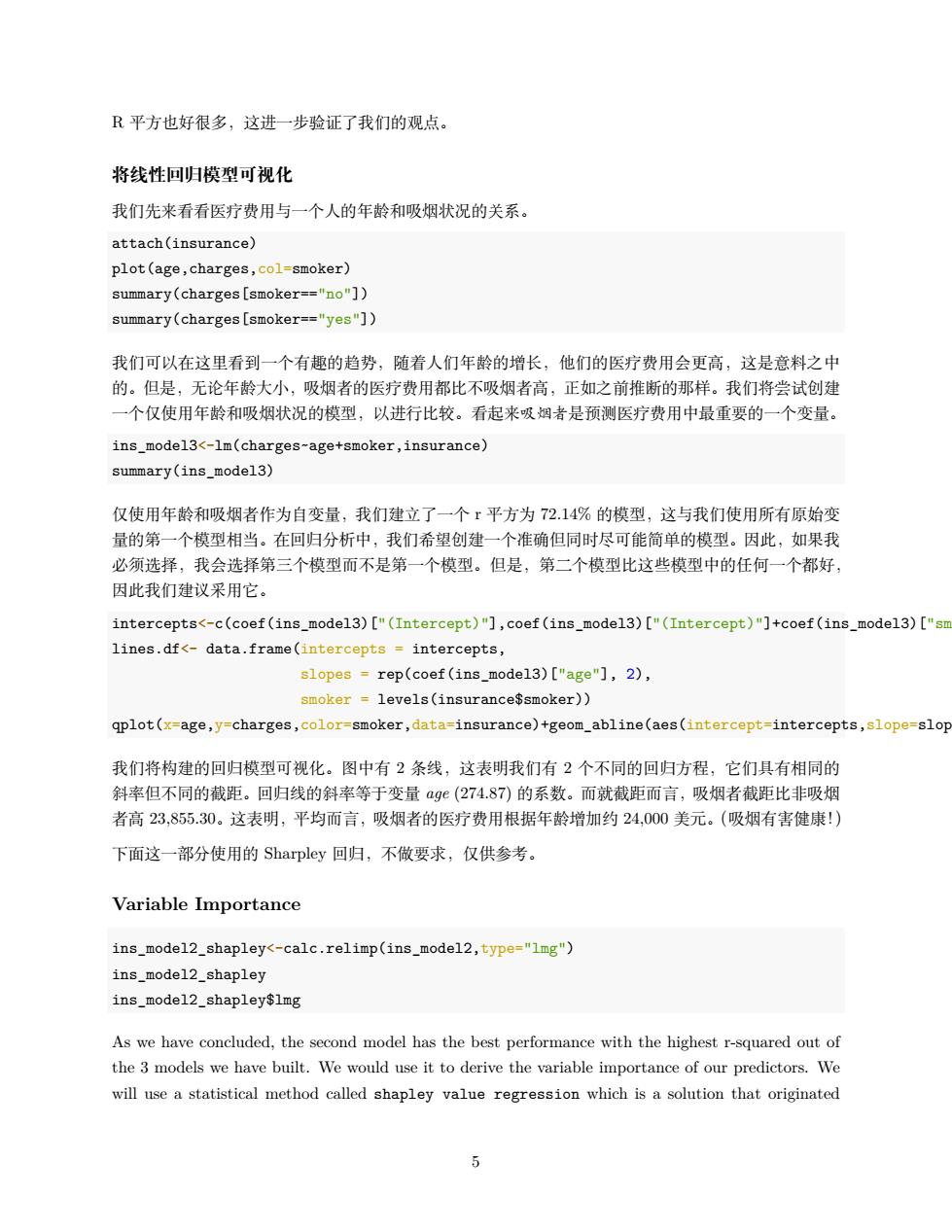正在加载图片...

R平方也好很多,这进一步验证了我们的观点。 将线性回归模型可视化 我们先来看看医疗费用与一个人的年龄和吸烟状况的关系。 attach(insurance) plot(age,charges,col-smoker) summary(charges [smoker=="no"]) summary(charges[smoker--"yes"]) 我们可以在这里看到一个有趣的趋势,随着人们年龄的增长,他们的医疗费用会更高,这是意料之中 的。但是,无论年龄大小,吸烟者的医疗费用都比不吸烟者高,正如之前推断的那样。我们将尝试创建 一个仅使用年龄和吸烟状况的模型,以进行比较。看起来吸烟者是预测医疗费用中最重要的一个变量, ins_model3<-1m(charges-age+smoker,insurance) summary(ins_model3) 仅使用年龄和吸烟者作为自变量,我们建立了一个r平方为7214%的模型,这与我们使用所有原始变 量的第一个模型相当。在回归分析中,我们希望创建一个准确但同时尽可能简单的模型。因此,如果我 必须选择,我会洗择第三个模型而不是第一个模型。但是,第二个模型比这些模型中的任何一个都好 因此我们建议采用它。 intercepts<-c(coef(ins_model3)["(Intercept)"],coef(ins_model3)["(Intercept)"]+coef(ins_model3)["sm lines.df<-data.frame(intercepts=intercepts, slopes -rep(coef(ins_model3)["age"],2), smoker levels(insuranceSsmoker)) qplot(x-age,y=charges,color-smoker,data-insurance)+geom_abline(aes(intercept-intercepts,slope=slop 我们将构建的回归模型可视化。图中有2条线,这表明我们有2个不同的回归方程,它们具有相同的 斜率但不同的截距。回归线的斜率等于变量ag(274.87)的系数。而就截距而言,吸烟者截距比非吸烟 者高23,855.30。这表明,平均而言,吸烟者的医疗费用根据年龄增加约24,000美元。(吸烟有害健康!) 下面这一部分使用的Sharpley回归,不做要求,仅供参考 Variable Importance ins_model2_shapley<-calc.relimp(ins_model2,type-"lmg") ins_model2_shapley ins_model2_shapley$1mg As we have concluded,the second model has the best performance with the highest r-squared out of the 3 models we have built.We would use it to derive the variable importance of our predictors.We will use a statistical method called shapley value regression which is a solution that originated R 平方也好很多,这进一步验证了我们的观点。 将线性回归模型可视化 我们先来看看医疗费用与一个人的年龄和吸烟状况的关系。 attach(insurance) plot(age,charges,col=smoker) summary(charges[smoker=="no"]) summary(charges[smoker=="yes"]) 我们可以在这里看到一个有趣的趋势,随着人们年龄的增长,他们的医疗费用会更高,这是意料之中 的。但是,无论年龄大小,吸烟者的医疗费用都比不吸烟者高,正如之前推断的那样。我们将尝试创建 一个仅使用年龄和吸烟状况的模型,以进行比较。看起来吸烟者是预测医疗费用中最重要的一个变量。 ins_model3<-lm(charges~age+smoker,insurance) summary(ins_model3) 仅使用年龄和吸烟者作为自变量,我们建立了一个 r 平方为 72.14% 的模型,这与我们使用所有原始变 量的第一个模型相当。在回归分析中,我们希望创建一个准确但同时尽可能简单的模型。因此,如果我 必须选择,我会选择第三个模型而不是第一个模型。但是,第二个模型比这些模型中的任何一个都好, 因此我们建议采用它。 intercepts<-c(coef(ins_model3)["(Intercept)"],coef(ins_model3)["(Intercept)"]+coef(ins_model3)["smokeryes"]) lines.df<- data.frame(intercepts = intercepts, slopes = rep(coef(ins_model3)["age"], 2), smoker = levels(insurance$smoker)) qplot(x=age,y=charges,color=smoker,data=insurance)+geom_abline(aes(intercept=intercepts,slope=slopes,color=smoker),data=lines.df) + theme_few() + scale_y_continuous(breaks = seq(0,65000,5000)) 我们将构建的回归模型可视化。图中有 2 条线,这表明我们有 2 个不同的回归方程,它们具有相同的 斜率但不同的截距。回归线的斜率等于变量 age (274.87) 的系数。而就截距而言,吸烟者截距比非吸烟 者高 23,855.30。这表明,平均而言,吸烟者的医疗费用根据年龄增加约 24,000 美元。(吸烟有害健康!) 下面这一部分使用的 Sharpley 回归,不做要求,仅供参考。 Variable Importance ins_model2_shapley<-calc.relimp(ins_model2,type="lmg") ins_model2_shapley ins_model2_shapley$lmg As we have concluded, the second model has the best performance with the highest r-squared out of the 3 models we have built. We would use it to derive the variable importance of our predictors. We will use a statistical method called shapley value regression which is a solution that originated 5